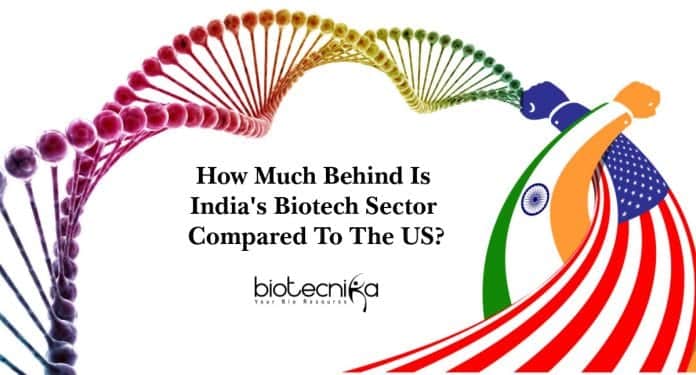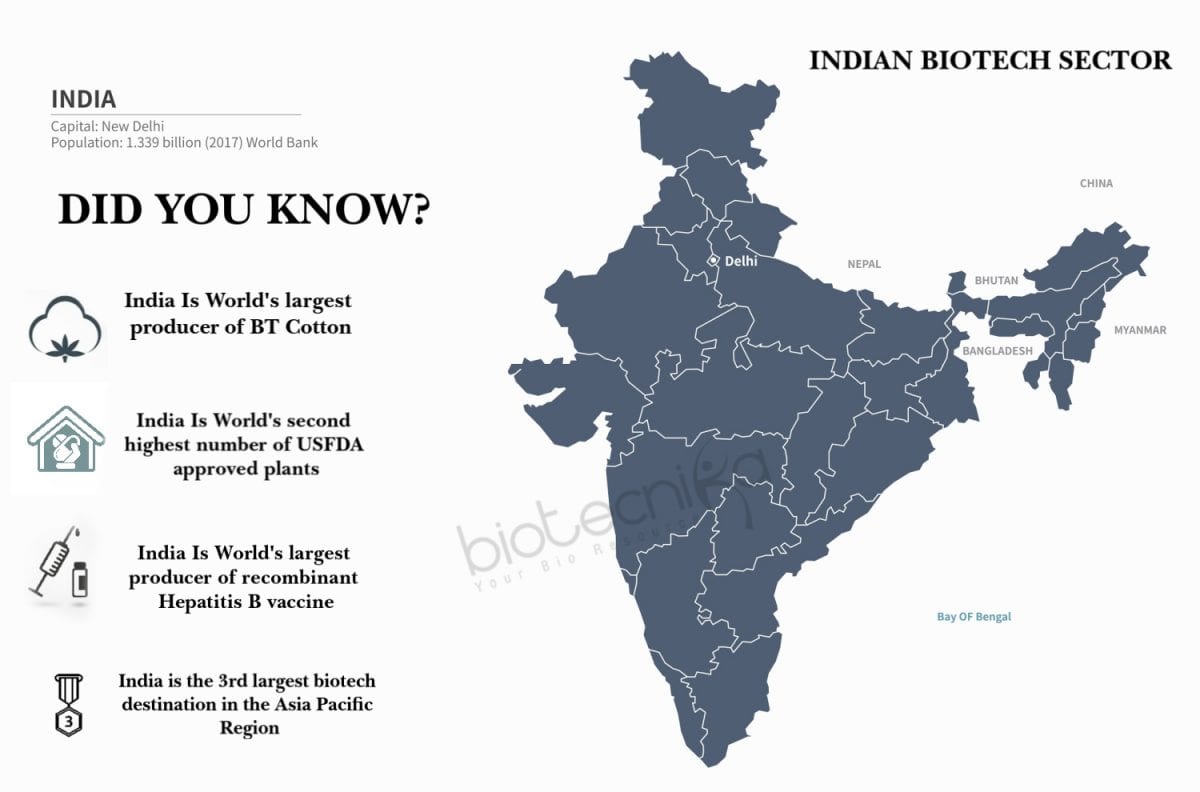Biotech Sector in India and the USA – The growth of biotechnology in India
India is a land of diversity. There are numerous talents across the country, who contribute towards economic development. If we look at the growth of the Biotechnology sector in India, it has been evaluated to about $ 51 bn in 2018, growing at 14.7% year-on-year. The industry is divided into five major segments- Bio-pharma, Bio-services, Bio-Agri, Bio-industrial, and Bioinformatics. However, if we compare it with the US, we are far behind.
The Indian biotech sector holds only 2% of the global market share while the United States is the leading global biotech player, with over 112 billion U.S. dollars of revenue and the industry’s total market capitalization of some 700 billion U.S. dollars. More than 130 thousand people are employed by U.S. public Biotechnology companies.
To understand the Biotech sector in India and the USA and their difference, let us look into the employment market in both countries.
The biotech sector in India Vs. The USA – The Key Players:
The Biotech sector is mainly driven by the Biopharmaceutical drug industry, for which, the USA and Europe are the world leaders. A few companies that have topped the profit margins this year would be Seattle Genetics, Biogen, Asterias biotherapeutics, Allergan, Gilead Sciences, Abbvie, Nanostring Technologies, and so on.
India, on the other hand, holds roughly 2% of the world market with the top profit-producing players being Sun Pharmaceuticals, Lupin, Dr. Reddy’s Laboratory, Cipla, Aurobindo Pharma, Zydus Cadila Healthcare, Piramal Enterprise, Glenmark Pharmaceuticals, Torrent Pharmaceuticals.
India holds plenty of Multinational companies as well. To name a few – Roche, GlaxoSmithKline, Pfizer, Sanofi Aventis, Merck, Johnson & Johnson, Amgen, Novartis, and so on.
In terms of generic drugs, India accounts for about 20% of global exports in terms of volume, making it the largest producer of generic drugs globally. According to the Department of Pharmaceuticals, Ministry of Chemicals and Fertilizers, domestic pharmaceutical market turnover has been estimated to be US$ 19.14 billion in FY19, with Hyderabad, Mumbai, Bangalore, and Ahmedabad being the major pharmaceutical hubs of India.
India as a player:
The advantage that India has over the other nations like the USA, is the abundant talent pool and the ability to think of a solution to every problem in a new way. The majority of the Indian market deals with expertise in reverse-engineering new processes for manufacturing drugs at a very low cost. That has cut down the monopoly in the global market. India being one of the chief exporters, has seen a huge share margin with the US, South Africa, Russia, UK, Nigeria, Kenya, Tanzania, Brazil, Australia, Germany, and so on, with the US being its leading partner. Though the global market has a lot of infrastructure and resources, it does not quite cater to the individual Indian market needs, which is why within the last decade, India has seen quite a few Entrepreneurs make its name in the global market, with industries contributing to Precision medicine, Pharmaceutical R&D, etc.
The Western countries did not address and invested in Indian diseases as it was not profitable enough for them, which is why our country has to develop its own resources and techniques. With the initial cost of investment being very high and not appealing to the Indian market, more and more indigenous entrepreneurs begin to work in this sector, trying to lower the average cost of production and make it more affordable for the common man. In this bargain, the global monopoly has been brought to an end, with India now offering better products at a low cost.
The biotech sector in India Vs. USA – What is amiss?
However, if we look at the Indian technology and research, there always arises a question of quality. Multiple surveys over the past 3-5 years have often raised questions on various production units, research articles, and findings. Forging data, manipulation, non-reproducible data, lack of process has often been an issue that has held the Indian market from being a dominant player.
However, as the scientists and entrepreneurs realize this issue and work towards it, the market dependency and faith will increase.
This is why it becomes the duty of every aspiring scientist to be true to his work and work both hard and smart to achieve this dream for our country.
What drives the zeal?
The choices and needs of the rising middle class are what drives the Indian market. Catering to its needs is one of the goals that have allowed multiple entrepreneurs to create their niche in the market. Whether we look at Biocon, Bharat Biotech, or even Mapmygenome, the idea behind it all is to make medicine and treatment affordable to our citizens and to become a player in the global market. India may not be as competent financially as the Western countries, but it sure has a Human capital that is even targeted by the Westerners. Biotech Industrial programs, finishing schools, have taken the motto of training 100s of 1000s of Biotechnology graduates to make them ready for absorption in the industry for faster results. The skills and knowledge level development over the last decade is quite evident. DBT, CSIR has worked hard in recruiting the scientific workforce that will drive the countries future.
Bio-pharma
Bio-pharma industries are into the production of a multitude of therapeutic drugs, gene therapy vectors, monoclonal antibodies, and vaccines. The United States holds the largest market for biopharmaceuticals accounting for one-third of the global market. The United States is the leading country in terms of Biopharmaceutical R&D. More than 800000 people are employed in the biopharma industry in the US, supporting around 4.7 million jobs indirectly or directly. U.S. firms conduct over half the world’s R&D in pharmaceuticals ($75 billion) and hold the intellectual property rights on most new medicines.
On the other hand, India is far behind the United States, accounting for only 3% of the global bio-pharma market. However, 70% of the biotech sector in India comprises of bio-pharma segment. Among the 325 biotech companies in India, more than 19% are in the biopharma sector.
Agri-Biotech
The global agricultural biotechnology market was approximately USD 32.89 billion in 2018 and is expected to generate around USD 67.01 billion by 2025, at a CAGR of around 10.7% between 2019 and 2025. The US Agri-biotech market was valued at US$ 7.42 bn in 2018. In the agricultural biotech sector, India, too, has a spot as it belongs to the list of agricultural countries. The genetically modified cotton, commonly known as BT cotton, today, in India, constitutes approximately 77 % of the revenue of this sector. In contrast, biopesticides, biofertilizers, and tissue culture together account for 23% of the revenues garnered by agricultural biotechnology.
However, the Indian market slows in growth due to the rising ethical issues and concerns circulating the genetically modified species. Indian agriculture faces the formidable challenge of having to produce more farm commodities for our growing human and livestock population from diminishing per capita arable land and water resources. Biotechnology, in combination with classical breeding techniques, has the potential to overcome this challenge to ensure the livelihood security of over 110 million farming families in our country. Considering that agriculture is vital to India, there is substantial public sector investment in agri-biotech. Private sector investments, by comparison, are still comparatively low. National research emphasis has been on the genomics of rice, chickpea, wheat and tomato, and on tolerance to biotic (diseases and pests) and abiotic (drought, salinity) stress.
Bio-Services
After Biopharmaceuticals, Bio-services are the second largest sector of the Indian biotech sector, with about 33% market share. The bio services industry includes CRO’s, both Clinical Research Organizations (that carry out clinical trials of potential therapeutic drugs before they are launched in the market) and Contract Research Organizations (that manufacture bulk chemicals or API’s on a contract basis for larger international firms). 16% of the global population resides in India, with 20% of the global disease burden making India the natural destination for bio-services. Yet only 1.4% of global clinical trials are carried out in India. Currently, there are nearly 600 trials that include drugs, surgical procedures, devices, and treatments that are carried out in India. In 2017, the Indian clinical trials market was estimated to be USD 1.6 billion, with a promising CAGR of 8.7%
Bio-Industrial
The bio-industrial sector mainly comprises of enzymes that have multiple industrial uses and the generation of bio-energy through sources such as biomass and biofuels. The bio-industrial sector in India registered an 8% growth in its revenues, with total sales of $142 million. The enzymes sector is growing, fuelled by the steadily rising Indian middle-class economy, where there is a growing tendency towards an increase depending on food, drugs, textiles, and leather products. Novozymes, the biggest player in this sector, is rapidly expanding its presence in India by developing the enzymes sector for the food, beverages, and home-care market.
India faces formidable challenges in meeting its energy needs. In order to maintain an annual GDP growth of 8% over the next 25 years to meet its goals for poverty elimination, the country needs to triple its primary energy supply and quadruple its electricity supply. India now imports about 65% of its petroleum, and with demands mounting this could surely increase to 90% by 2025. In this scenario, renewable energy sources such as biofuels represent an attractive option. India’s thrust is on producing ethanol from cellulose biomass, including agricultural and forestry waste, biodiesel from varied feedstocks, and optimally harness the energy potential of natural resources for conversion to alternative fuel.
The main challenge is to apply biotech tools for improving the biomass production system, promote the biorefinery concept aiming at the integral use of biomass, and maximizing the cost-effectiveness of the final product. Biotech interventions are being used to reengineer feedstock for enhanced ethanol recovery and microorganisms for increased productivity. DBT has established an Energy Biosciences Centre at the University Institute of Chemical Technology, Mumbai, to develop economically and ecologically sustainable technology for biofuel from biomass and provide a platform for evaluating bioenergy-related technologies.
Bioinformatics
Bioinformatics contributes to the smallest part of the biotechnology industry in India. This particular sector deals with the creation and maintenance of extensive electronic databases on various biological systems and the tools and software to analyze the information derived from these databases. However, India is since long known for its strong IT base. Hence, it puts India in a favorable position as compared to other developing nations in becoming a leading destination for work in the bioinformatics arena.
The biotech sector in India Vs. USA – Challenges and limitations:
There are many challenges that have restricted the Indian Biotechnology sector from soaring its wings. A few of the issues that could be well tackled are
- Lack of proper regulatory processes for approval.
- Dependency on the import of foreign resources and reagents adds to the cost.
- Failing to sustain quality check and gain rapid approval for products
- Lack of public-private partnership
- Lack of driven resources and quality output
- Risk prone nature of the industry
- Lack of venture or angel funding
- Lack of ignition grants for young minds
India, as a country, has faced a lot of challenges in its history and is known to sail through the tough waters with flying colors. With the ever-growing talent community within India and the International partnerships and aid, the country will once again work towards polishing its knowledge and skills and rising up like a Phoenix from the ashes. All the state requires, is the young minds to understand the problems, have faith, and work towards success with truth and honor. The country has and always will be a land of talent, hard work, and knowledge, which makes it self sufficient and diverse.
 most experienced senior team members of Biotecnika. Coming from a research background in cancer, she specializes in Cancer Genetics, Immunology & Developmental Biology. Her experience in the Ph.D. Exam & Selection field is vast. She has a keen interest in understanding the latest developments in the Biotech & Pharma Industry and is very passionate about educating the same to her students.
most experienced senior team members of Biotecnika. Coming from a research background in cancer, she specializes in Cancer Genetics, Immunology & Developmental Biology. Her experience in the Ph.D. Exam & Selection field is vast. She has a keen interest in understanding the latest developments in the Biotech & Pharma Industry and is very passionate about educating the same to her students. Co-Author: Namitha Thampi































